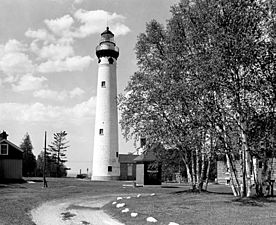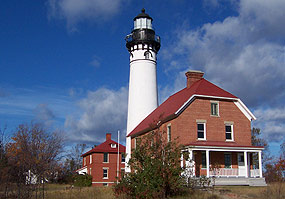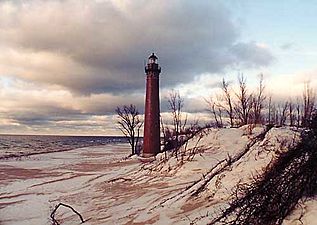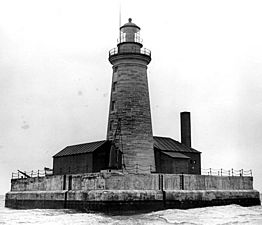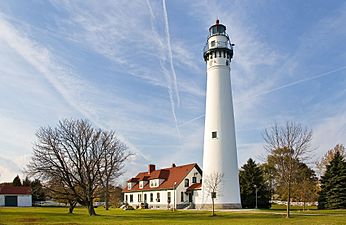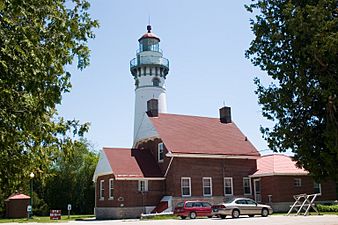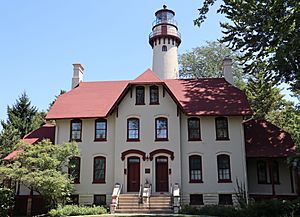Grosse Point Light facts for kids
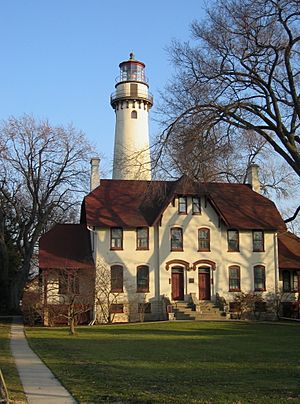 |
|
| Grosse Point Light Station | |
|
|
|
| Location | 2601 Sheridan Rd., Evanston, Illinois |
|---|---|
| Coordinates | 42°3′50″N 87°40′34″W / 42.06389°N 87.67611°W |
| Year first constructed | 1873 |
| Year first lit | 1874 |
| Automated | 1935 |
| Deactivated | 1941 but reactivated 1946 as Private Aid to Navigation |
| Foundation | Stone/Concrete |
| Construction | Cream City Brick encased in concrete Italianate bracketing |
| Tower shape | Frustum of a Cone tower attached to storage building |
| Markings / pattern | yellow w/red trim & red roof |
| Height | 113 ft (34 m) |
| Focal height | 119 feet (36 m) |
| Original lens | Second order Fresnel lens |
| Current lens | Second order Fresnel lens |
| Intensity | 68,000 candlepower |
| Range | Original: 18 nautical miles; 34 kilometres (21 mi) |
| Characteristic | 2 white flashes every 15 seconds |
| ARLHS number | USA-359 |
| USCG number | 7-20190 |
The historic Grosse Point Light is located in Evanston, Illinois. Following several shipping disasters near Evanston, residents successfully lobbied the federal government for a lighthouse. Construction was completed in 1873. The lighthouse was added to the National Register of Historic Places on September 8, 1976. On 20 January 1999, the lighthouse was designated a National Historic Landmark. It is maintained under the jurisdiction of the Evanston Lighthouse Park District, an independent taxing authority.
Contents
History
Impetus
The United States government agreed to construct the lighthouse at Grosse Point after several maritime disasters near the area showed need for it. Shoals were a real hazard, and ship traffic was increasing concurrent with development in the Midwest, the growth of Chicago, the aftermath of the Chicago Fire, and the increased trade and exploitation of natural resources throughout the Great Lakes. Particularly influential was the 1860 sinking of the Lady Elgin, a disaster which claimed more than 300 lives. The citizens of Evanston petitioned the government for the light station, but the Civil War (1861-1865) delayed any funding for the project. Lighthouses in Chicago proper were proving themselves insufficient, so there was a perceived need for action.
Construction
The project to construct a lighthouse began in 1872, supervised by Orlando Metcalf Poe, who designed the buildings. Most of the construction was completed by June 30, 1873, although the lamp would not be lit for several months. Finally, in March 1874, the light commenced operation. The building is designed in Italianate architecture.
In summer 1865 Colonel Poe became the Lighthouse Board's chief engineer; in 1870 he was promoted to the position of Chief Engineer of the Upper Great Lakes 11th Lighthouse District. In this capacity he designed eight "Poe style lighthouses" and oversaw construction of several. Poe was named District Engineer for the Eleventh Lighthouse District, Those lights are New Presque Isle Light (1870) on Lake Huron, Lake Michigan's South Manitou Island Light (1872), Grosse Point Light (1873) in Evanston, Illinois, Lake Superior's Au Sable Light (1874), Outer Island Light (1874) in the Apostle Islands, Little Sable Point Light (1874) on Lake Michigan, Cheboygan County, Michigan's Spectacle Reef Light {1874} on Lake Huron, Racine, Wisconsin's Wind Point Light (1880); and Manistique, Michigan's Seul Choix Light (1895).
In 1935, the federal government turned over the grounds and the buildings, except for the lighthouse tower and light, to the city of Evanston. In 1941, the Grosse Point Light Station was decommissioned by the United States Coast Guard as a precaution against possible air raids in the wake of the attack on Pearl Harbor. After the decommissioning, the city received the tower and the light. But the lease allows the government to take the light station back if they ever needed it for official use.
The light was reignited in 1945 and has served as a secondary navigational aid ever since. The lighthouse is operated by the Lighthouse Park District of Evanston, Illinois, once known as the Northeast Park District, but since renamed in honor of the lighthouse.
Illinois has two well-known and historic light stations in the Chicago area, plus two pierhead lights. Chicago has no area lighthouse preservation group, and this light has been the primary beneficiary of preservation efforts in the area. The Calumet Harbor Light—just across the border in Indiana, and one of eleven past or present lighthouses in Indiana, was demolished in 1995.
Architecture and design
Light tower
The Gross Point Light's primary structure is the conical light tower. The tower stands on a concrete foundation with wooden piles that reach to a depth of 30 feet (9.1 m). The tower's two outer walls include an inner air space between them. The inner wall has a thickness of 8 inches (200 mm) and rises vertically. The outer wall, at a thickness of 12 inches (300 mm), rises at a slight incline and gives the tower its conical shape. The tower begins with a 22-foot (6.7 m) circumference at its base and 13 feet 3 inches (4.04 m) at its parapet. The tower lantern is of glass and iron construction and is topped by a copper sheeting roof.
Lantern and optics
The second order Fresnel lens is the largest lens (one of five) placed on the Great Lakes, which underscores the importance of this light. The lens was manufactured by Henry-Lepaute Company of Paris. It is still in place, which makes it unique; it has been said that this is the single remaining 2nd Order Fresnel lens that is still in place and in service on the Great Lakes.
This is one of only 70 such Fresnel lenses that are still operational in the United States, sixteen of which are in use on the Great Lakes of which eight are in Michigan.
Grosse Point legends
The site of the Grosse Point Lighthouse is the purported site where Father Jacques Marquette landed in 1674 during his trip down the west side of Lake Michigan to visit various Illinois Native American tribes. This tale is largely anecdotal as there is no real historical proof that this ever occurred.
Current activities
The light is 13 miles (21 km) north of Chicago, just north of Northwestern University. Notwithstanding that it is outside the corporate limits of Chicago, it is said: "The keeper's house is Chicago's only maritime museum; one fog signal building serves as a visitor center while the other houses a nature center" The dwelling and tower are opened during summer weekends for tours.



